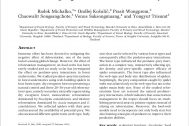Obsah
Immense effort has been devoted to mitigating the negative effect of deforestation, one of the main factors causing global change. However, the effect of reforestation management on food-webs has been rarely studied and no study so far has investigated the effect on predator–prey interactions in forest understories. We studied predator–prey interactions in forest understories using web-building spiders in four forest types: dry evergreen forest representing a natural control and three 20–30-year-old reforestation types, namely secondary naturally regenerating dry evergreen forest, monoculture reforestation dominated by Eucalyptus camaldulensis, and mixture reforestation dominated by Acacia mangium and E. camaldulensis. We collected spiders with their prey and measured the availability of potential prey. We also measured different spider traits (web type, body size) that can be selected by various forest types and consequently affect the predator–prey interactions. The forest type influenced the predator–prey interaction in a complex way, interactively affecting spider density and prey-specific capture efficacy of spider community. The forest type also influenced the web-type and body-size distributions of spiders. Surprisingly, the prey composition caught by spider webs was related only to the web-type but not to the spider mean body size. None of the studied reforestations have yet restored the natural predator–prey interactions, which indicates that conservation management in the tropics should focus on establishing protected areas in pristine regions instead of relying on reforestation. Moreover, the food-web models need to incorporate not only body sizes but also hunting strategies of predators to improve their predictive abilities.



